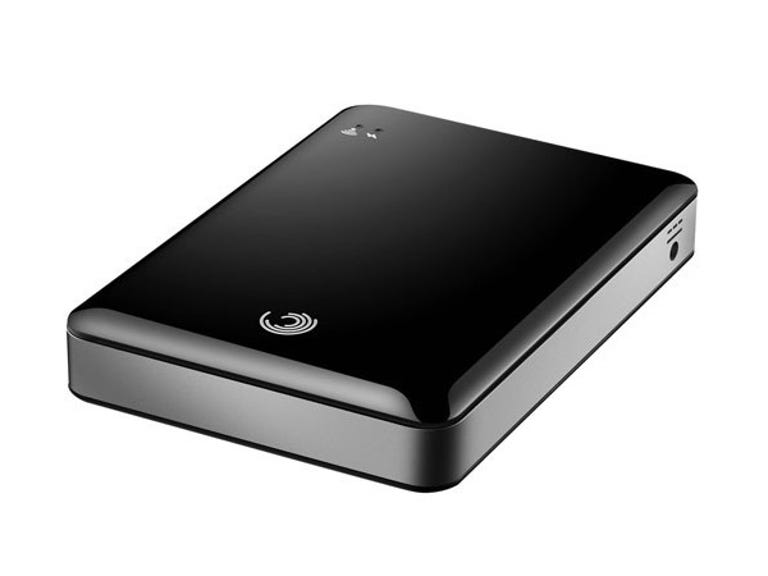 Why You Can Trust CNET
Why You Can Trust CNET Seagate GoFlex Satellite (500GB) review: Seagate GoFlex Satellite (500GB)
Seagate expects a premium for its Wi-Fi feature, but it's one with many limitations. The Satellite will appeal to a tiny niche, but the rest of us will want more bang for our buck.
The concept is sound: a portable hard drive that creates its own Wi-Fi hotspot to stream media to portable devices like iPads and iPhones (amongst many others). But this system comes with many first-generation drawbacks.
The Good
The Bad
The Bottom Line
Design
The Satellite looks exactly as you expect it to; a glossy black box with the footprint of a passport but thicker. Seagate's design is sharp and simple, with a nice silver-coloured trim and a minimum of ports, buttons and LED lights. On the base of the Satellite is a single proprietary USB port for data transfers with a PC (or Mac) and charging the hard drive to its five-hour playback capacity.
It's lightweight too, at only 260 grams, so there's no issue with chucking the GoFlex Satellite in a bag and lugging it around with your laptop or tablet.
Features
Wi-Fi is central to the user experience of the GoFlex Satellite, and it's this feature that sets the drive apart from most of its competitors. Inside the case, alongside the 500GB hard drive, is a Wi-Fi radio compatible with the 802.11b/g/n protocols. When you turn the Satellite on, the Wi-Fi chip switches on, too, creating a personal hotspot dedicated to the hard drive. You then connect to the drive the way you would to any Wi-Fi network from whichever device you are using.
Once connected you can access any media stored on the drive and stream it to your tablet, phone or computer. If you are using iOS or Android there are dedicated apps to download through the respective App Stores and Markets, and if you are using anything else you simply launch the web browser on the device to see the Seagate media menu. These apps and web-based user interfaces are colourful and well designed with clear option titles and a finger-friendly layout. The Satellite supports WPA security, and while this is a lightweight security profile, it should be sufficient to protect a device that you can neither write to or from.
The major downside to this set-up is that the software only supports data transfers in one direction; you can stream media from the Satellite, but you can't push data to it over Wi-Fi. In fact, you can't permanently transfer data from the hard drive to a connected PC, etc, only temporarily transfer data during a media stream. This is a big chink in the Satellite's armour, which massively restricts the use cases for this drive down to just "sitting on [insert mode of transport] and listening to/watching media". When you are paying a huge premium for the Wi-Fi component in this drive, we'd expect it to be more versatile.
Performance
Seagate's website advertises "reliable skip-free streaming" up to 30 feet, or just over 9 metres. This is an extraordinary claim if you think about it: 9 metres will be the distance across two, maybe three, rooms in a house, so you really do have to think about where you will watch the movie on your iPad and make sure the Satellite is nearby — there's no setting it next to your PC and forgetting about it.
Anecdotally, we found this meant that you can have the Satellite in one room and use it in the room adjacent, but no further. Obstacles of more than a single solid wall were often too much for the Satellite's Wi-Fi radio, where our video files would pause to buffer frequently enough to make the videos unwatchable.
On the topic of video files, it's worth noting that the GoFlex Satellite is not a media renderer: it pushes the media files to your portable device, but it is still the device's responsibility to play the files. For example, on a Galaxy S II smartphone we could play some DivX video content, but on an iPad 2 we could only play H.264, MP4 or QuickTime files, as per the limitations of Apple's tablet.
The GoFlex satellite supports up to three simultaneous streaming connections, a claim we were able to verify when all devices were in reasonably close proximity to the drive. Seagate estimates 5 hours of streaming playback to a single user and 25 hours of standby.
Overall
In certain circumstances, the wireless component of the GoFlex Satellite will be a godsend. Those regularly away from home on long-haul flights will appreciate the portability of this hard drive and its ability to communicate with tablets and laptops without the need for cables.
But most other people shopping for a portable hard drive will quickly notice that you could pay a third of the asking price of the 500GB GoFlex Satellite and get double the storage. This cheaper hard drive won't communicate wirelessly with your iPad, but then is this feature really worth the extra AU$100-plus you'll pay for the Satellite? If Seagate releases a similar drive that you can transfer data to and from over Wi-Fi then we'll be excited to see it, but as it stands, we recommend you have a close look at the Satellite in its current form, with its various limitations, before committing to a purchase.


